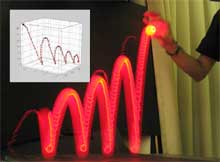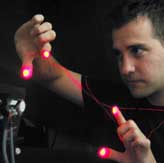Input of information is becoming a challenging task as portable electronic devices become smaller and smaller. Smart Laser Scanner for Human-Computer Interface allows users to input data by just executing bare-handed gestures in front of a portable device – that could then be embodied in a keyboardless wrist-watch.
Ultimately, coupling such interface with a projective display (e.g. an eyeglass-mounted display or even a laser-based display) capable of creating a large virtual space would completely remove the need of any real interaction area for viewing or inputting data, allowing further downsizing of mobile computing devices.


The team’s tracking system is currently using a laser diode (visible or invisible light), steering mirrors, and a non-imaging photodetector, which is capable of acquiring 3D coordinates in real time without the need of any image processing at all. Essentially, it is a smart rangefinder scanner that instead of continuously scanning over the full field of view, restricts its scanning area, on the basis of a real-time analysis of the backscattered signal, to a very narrow window precisely the size of the target.
Developed by Alvaro Cassinelli, Stephane Perrin and Masatoshi Ishikawa at the University of Tokyo. See also their Khronos Projector.
